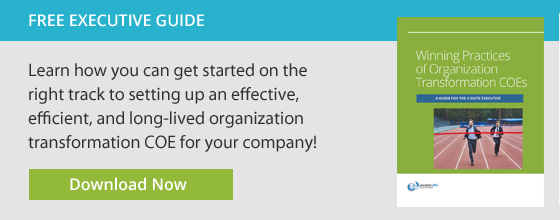A Center of Expertise (COE) is set up to deliver specialized services or capabilities for a business. A properly set up internal COE for implementing organization change can help an organization handle change more smoothly, efficiently, and cost effectively.
The critical first step in setting up a successful organization transformation COE is to define its purpose and intent. To do this effectively, it is helpful to ask the following key questions:
- What business problem is the COE being set up to help solve, and what is the best solution for that problem?
- How will the business use the COE once it’s set up?
- Is there a strong business case for investing in building the COE?
Gaining clarity on these three points will help the COE team make sound decisions in alignment with the organization’s needs. It will also help prevent ambiguities and misunderstandings that could undermine the COE’s effectiveness down the line.
Let’s explore each of these questions in more depth.
Key Question #1: What Business Problem Will the COE Help Solve?
COE’s are set up for a variety of reasons, but always in response to one or more challenges faced by an organization. For example, how to facilitate large-scale change in less time or how to redesign an organization without incurring excessive consulting spend. When choosing an approach for your COE, executives should first determine what problem the COE is meant to address. Then, consider what types of solutions might best address the opportunities at hand.
A COE may be set up to perform one or more of the following roles:
- Provide expert advice and/or coaching to leaders within the organization who want to undertake a transformation. In this capacity, the COE takes on an internal consulting role for implementing organization change, helping leaders set up their transformation and/or frame the problem or approach. With this approach, the COE’s focus is on advising rather than doing.
- Act as a repository of tools, approaches, and/or data, making available to leaders the tools and approaches that can help them undertake a big transformation—including training, online access, and/or targeted coaching. An organization transformation COE can also act as a repository for data, collecting information about the organization and making it available to those who need it.
- Provide hands-on assistance in leading, facilitating, or managing the project or transformation. In this model, staffing is a challenge because demand will often outstrip resources.
A very common COE failure mode is a lack of clarity about which role the COE is trying to deliver. If the COE is not able to effectively communicate the scope of what it offers, it can create confusion and hard feelings, and/or weaken the COE’s effectiveness.
For instance, it’s natural for people asking for advice to cling to the advisor and want them along on their entire transformation journey. However, if a COE is lightly staffed and set up only to provide expert advice, doing so can make the limited advisory resources unavailable to others. Failure on the part of the COE to clearly communicate their delivery model or approach can result in the COE being spread too thin, or ineffectively juggling the simultaneous needs of multiple leaders or areas of the company.
Because large organizations may have several transformations going on at once, even a staff of ten or twelve people may not be adequate to support all of the work and needs of the organization. It is best to align service availability to available resources (or at least to the investment level the organization is willing to commit) and clearly communicate the scope of those services than to try to do too much or be undisciplined about the focus and intent of the COE.
Key Question #2: How Will the Business Use the COE?
To a large extent, the problem the COE is set up to address and the delivery approach it takes will dictate how the business will leverage the capability. However, it is important to consider what factors should act as triggers in the business leader’s mind to seek help from the COE. Ideally, executives should know exactly when to seek the help and services of the organization transformation COE.
To help encourage this, the COE needs to do the following:
- Clearly articulate its capabilities and the intake processes for requesting support/work
- Invest in educating leaders on the disciplines and areas of expertise the COE offers
- Build a portfolio of successes – stories that can be shared to reinforce the capabilities of the COE and its impact
Some common triggers for a leader to reach out to the COE might include the following:
- Business expansion or growth that will require significant organizational change
- New strategy or marketplace position
- Development and launch of a new product, platform, or offering different from previous efforts
- Business model change (including Digital Transformation)
- Complexity (lack of ownership; unclear decision rights; competing demands, initiatives, and/or priorities; ineffective coordination, etc.)
- Merger, acquisition, or divestiture
- IT Systems changes
- Cost reductions or savings
- Culture change/renewal (e.g., Agile ways of working)
- Organization health check/review to ensure the organization is capable of delivering value
These might not represent all of the possible triggers, and it is possible some of these triggers won’t apply to each COE, but knowing what the triggers are should help guide leaders to seek help at the right time and for the right things.
Some COEs function like a service-based business that responds to inbound calls for assistance and then dispatches someone to do the work. Another strategy is for the COE to get tapped into the organization’s strategic planning process so that when strategic initiatives are identified they know it and are able to proactively step in and assist.
Key Question #3: Is There a Business Case for the COE?
Answering the first two defining questions should provide a clear picture of the basic approach and delivery model of your COE. At this point, before committing to hiring and/or allocating resources to the COE, it’s time to take a good hard look and objectively determine whether there is a legitimate business reason to invest.
- Will it enable faster or better performance?
- Will team members’ knowledge and intimacy with the business result in higher quality or more effective organization transformation results?
- Will the COE enable the organization to offload external spend?
Even if these questions can be answered in the affirmative, it is also important to ask whether building internal capability truly is the best option now and down the road—or might there be other solutions available that would better serve the organization’s strategic goals? Only once a solid business case has been determined should leaders move forward in creating a COE for implementing organization change.






